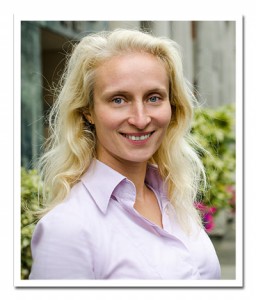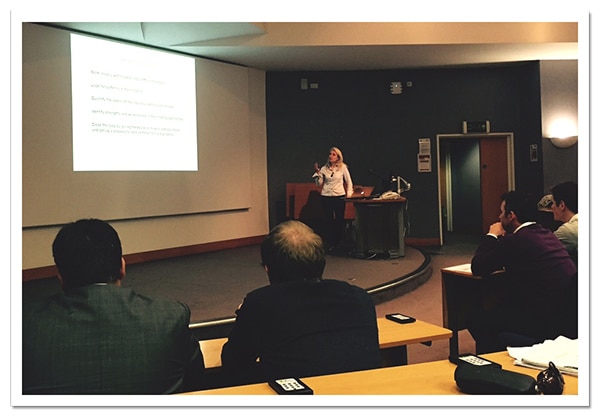Share post
Snežana, you’re a Senior Quantitative Researcher at Essentia. What does that entail?
I’m part of the research team at Essentia’s London office and my work involves analysing our clients’ data and finding ways to extract actionable behavioural insights from it. Given that portfolio managers and traders are very busy people, a big part of what I do is design data processing techniques that deliver this kind of in-depth analysis quickly and accurately.

A bit of both, actually. I studied theoretical mathematics at home in Serbia, as well as in the UK. For my PhD, at the London School of Economics, I shifted my focus to applied mathematics and did some interesting work supported by the Radiocommunications Agency – helping them to optimise mobile phone coverage through the assignment of a spectrum of frequencies to radio transmitters. After my PhD, I joined a hedge fund called GLC and was there for 10 years.
What was behind your shift from pure research to applied data science?
I enjoy research in both contexts but I get a much greater buzz from working with real-world data and scenarios because they’re more results-driven. At Essentia, I’m often dealing with very hard, knotty data puzzles, but it’s enormously satisfying to find the solution and then see it out there, being used and validated by professional investors. By contrast, pure research tends to be more insular, often with idealised and simplified assumptions driven by the fact academics generally have less real-life data to work with.
Tell us about your time at GLC. What did you do there?
When I joined GLC, it was a successful hedge fund managing mostly European equities and futures. My role there was to develop quant-driven trading strategies. During my PhD, I got very interested in financial markets so, at the time, it was something like a dream job for me. And it was there, obviously, that I learned how things worked for professional investors.

Snežana presenting Essentia’s research approach at University College London’s
Department of Computer Science (June 2015).
Is this where your interest in performance analysis began?
Yes, that’s right. The trading models we built at GLC allowed for a degree of manual override, giving the traders and portfolio managers some latitude in their activity. Not surprisingly, they were very keen to understand how their discretionary overrides contributed to the fund’s performance outside of the model. That included risk analysis, but also what was driving their individual performance – such as if a particular country bet was working for them, or whether their shorts were more successful than their long positions. I’d crunch the numbers to answer those questions for them.
So you became their personal feedback loop?
Correct. I could see there was a real demand for this information, and my quantified feedback became a bit like another stage to their investment process. Also, I could see it gave the fund managers and traders confidence to actually know where their skills lay and where they were weaker. Having had this experience is why I’m so passionate about what Essentia is doing.
Did behavioural finance influence your work in this area?
Yes and no. I remember attending a talk by Dan Ariely at the LSE in 2008. His work on investment decision-making provided a very logical, data-driven overlay to the some of the performance characteristics I was seeing at GLC – particularly on the equities side. But, like many hedge funds, whilst we wanted to examine the implications properly, we simply didn’t have the time.
Fast-forward to the present and you’re now part of the London’s flourishing FinTech scene. What’s it like working at Essentia?
I like it! It’s a very sparky atmosphere. I’m used to working in a busy environment with very bright people but what stands out here is the real diversity of experience and technical knowledge. I’m working with ex-money managers and traders, software developers, UI specialists, neuroscientists and passionate mathematicians like me. The key is that everyone understands the global problem we’re working on, even though we each have our own responsibility for implementing different parts of the solution. I think this kind of ‘cohesive diversity’ is very valuable when you are pushing the boundaries of what has been done before.
And is there diversity in the kind of client data you’re looking at?
Yes. Trade and market data reveal a lot about portfolio performance and the investment manager’s cognitive biases. But we’re actively extending this notion of ‘client data’. Academic research now continually shows that there is a multitude of factors that impact meaningfully on investment decision-making.
Developments in technology (such as our journaling tool, Essentia Note, and wearable technology, like Jawbone and Fitbit), have made it possible to capture data about those factors and, as a result, we can now analyse data on everything, from the intent and conviction behind investments, through to sleep quality and stress levels. It’s fascinating data to work with.
Can you give us an example of something you’re working on right now?
Sure – there is plenty to talk about, but a good example is work we’re currently doing on the relationship between mood and investment decision.
This talks to the kind of non-market data I just mentioned but is extra interesting because it’s the first time this analysis has been done outside of a pure research environment.
In a nutshell, we’re building a mathematical framework which can accurately align and draw out the ongoing relationships between these two factors for any given client.
For the decision data, we take a feed of the portfolio manager’s trades and analyse it carefully so we can answer the question, “what investment decisions did this person make today?”. The picture of the manager’s mood is constructed from information about attitude, well-being and health that we collect from each client on a daily basis. An important part of this research is finding the best way to present the analysis so the client can understand the patterns easily and use it to manage their own performance.
We’re also working closely with the developers so the ‘deep analysis’ involved here can be delivered at a click. That’s very different to traditional systems that need to churn the data around for much longer before reporting.
For me, as a mathematician, this is very exciting stuff, and it is an example of how when you get clever with data, it can become truly beautiful.
Are clients involved in functionality initiatives like this?
Yes, always. We’re in constant dialogue with them and won’t start on something until we’ve really thought about how different clients could use it. It’s an important part of the Essentia ethos that we’re building tools which answer the questions a portfolio manager really wants to ask about his own activity – as opposed to producing more general, ‘one-size-fits-all’ reporting.
How does the level of analysis that Essentia provides change a user’s investment process?
We definitely see managers having ‘Aha’ moments when they use the Essentia’s software. Sometimes it confirms a hunch they already had or reveals a previously hidden characteristic in the way they trade or manage their positions.
For example, our entry and exit analytics may reveal that a manager is good at entering a position but then tends to wait too long to get out, especially when he’s losing money. Knowing this about himself is helpful, but our software can take this awareness further by generating customised alerts, calling the user’s attention to that pattern next time it arises.
For me, this illustrates how the new union between technology and behavioural science is helping humans be better investors.
But, going back to your question, I should stress that our software isn’t designed to change a portfolio manager’s investment process, so much as to help him optimize it and stay disciplined in implementing it. My work is to support that manager or trader in the way they’re making money – we’re not here to tell them what to do.
Thanks for your time, Snežana.

